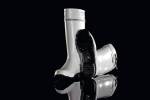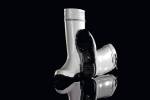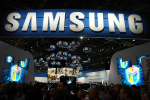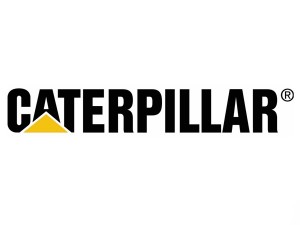Nokia’s destiny: From boots to phones to… boots
The year 1973 was crucial for one for the giants of European industry. That was when Finnish Rubber Works merged with Finnish Cable Works, forming a company called Nokia Corporation. That year, Nokia had a massive consumer market blockbuster with Kontio Rubber Boot. Kontio was named after the Finnish term of endearment for “bear” that was commonly used in Middle Ages to avoid the religious taboo against using the true name of this animistic deity (Karhu).
This groundbreaking footware introduced many key features that would become staples of modern rubber boot manufacturing: a tightening strap, a reflective band and a rotationally rigid midsole construction. Kontio would define the Nokia brand in Europe during late 1970s and the 1980s.
Read more here: Boy Genius Report
Apple and Samsung: Doomed to be frenemies forever?
Apple and Samsung have been at each other’s throats for years now, bickering over mobile patents and handset design elements in courtrooms around the world. Apple is thus far the only company to score a substantial win, having been awarded nearly $1 billion in damages following a favorable decision in its first big U.S. patent trial. But while these two giants continue to do battle in courts across the globe, Apple is still one of Samsung’s biggest customers as it buys billions of dollars worth of smartphone, tablet and computer components from Samsung’s manufacturing arm.
Are these two tech titans doomed to be frenemies forever?
Read more here: Boy Genius Report
NSA chief says terrorists are changing their behavior thanks to Snowden leaks
More than a year ago, former NSA contractor Edward Snowden began leaking thousands of confidential documents that he stole while working for the National Security Agency. The documents shined light on a number of controversial spying methods employed by the government agency, many of which were considered violations of American citizens’ privacy.
There are very good arguments for and against Snowden’s actions, and one of the most valid arguments against the leaks was the suggestion that terrorists would alter their behavior and strategies in order to avoid the now-public NSA monitoring tactics. As it turns out, the NSA has now confirmed that this is indeed the case — but the problem apparently isn’t as serious as many people had feared.
Read more here: Boy Genius Report
Caterpillar, Argonne Undertake Cooperative Virtual Engine Design
Internal combustion engines are poised for dramatic breakthroughs in improving efficiency with lower emissions, thanks in part to low-temperature combustion regimes. Such regimes show great efficiency and emissions potential, but they present optimization and control challenges that must be addressed before they enter the engine mainstream.
Caterpillar Inc., in Peoria, IL, turned to U.S. Department of Energy’s Argonne National Laboratory and its Virtual Engine Research Institute and Fuels Initiative (VERIFI), where experts are developing new engine combustion models that incorporate accurate descriptions of two-phase flows, chemistry, transport phenomena and device geometries to provide predictive simulations of engine and fuel performance. Caterpillar and Argonne have entered into a Cooperative Research and Development Agreement (CRADA) along with Convergent Science, Inc., in Madison, WI, to further explore ways to predict how things work in diesel engine performance and emissions before any experimental work is conducted. This is the first such CRADA undertaken by VERIFI since its inception this spring.
Caterpillar anticipates that simulations developed by VERIFI’s researchers will reduce the time and cost of the design cycle for new engines, allow the rapid adaptation of fuels from new sources and lead to substantial increases in fuel economy while meeting future emissions standards. “Working with Argonne researchers will provide us access to their high-performance computing facilities and expertise in spray and combustion modeling that will improve our simulation practices at Caterpillar,” said Marcus Weber, team leader at Caterpillar.
Convergent Science is a world leader in computational fluid dynamics (CFD) software development. The company’s flagship product, CONVERGE, is used for CFD simulations in many industries. The staff at Convergent Science are experts in CFD simulations, numerical methods, model development and implementation and were instrumental in adapting high-performance computing practices in the CONVERGE code.
VERIFI applies state-of-the-art tools in high-performance computing, combustion chemistry, CFD, and experimental validation techniques to develop high-fidelity, three-dimensional, end-to-end, combustion engine simulation/visualization and fuel simulation. Advances in high-performance computing enable VERIFI researchers to run engine simulations in parallel on thousands, or even hundreds of thousands of processors. While efficient scaling of engine simulations to such massively parallel machines remains a significant challenge, such calculations will ultimately allow not only the rapid engineering of specific engine designs, fuels and operation conditions, but also allow their optimization.
Argonne National Laboratory seeks solutions to pressing national problems in science and technology. The nation’s first national laboratory, Argonne conducts leading-edge basic and applied scientific research in virtually every scientific discipline. Argonne researchers work closely with researchers from hundreds of companies, universities, and federal, state and municipal agencies to help them solve their specific problems, advance America’s scientific leadership and prepare the nation for a better future.
For more information, please visit science.energy.gov.
The post Caterpillar, Argonne Undertake Cooperative Virtual Engine Design appeared first on Engine Builder Magazine.
Read more here: Engine Builder Magazine
Caterpillar, Argonne Undertake Cooperative Virtual Engine Design
Internal combustion engines are poised for dramatic breakthroughs in improving efficiency with lower emissions, thanks in part to low-temperature combustion regimes. Such regimes show great efficiency and emissions potential, but they present optimization and control challenges that must be addressed before they enter the engine mainstream.
Caterpillar Inc., in Peoria, IL, turned to U.S. Department of Energy’s Argonne National Laboratory and its Virtual Engine Research Institute and Fuels Initiative (VERIFI), where experts are developing new engine combustion models that incorporate accurate descriptions of two-phase flows, chemistry, transport phenomena and device geometries to provide predictive simulations of engine and fuel performance. Caterpillar and Argonne have entered into a Cooperative Research and Development Agreement (CRADA) along with Convergent Science, Inc., in Madison, WI, to further explore ways to predict how things work in diesel engine performance and emissions before any experimental work is conducted. This is the first such CRADA undertaken by VERIFI since its inception this spring.
Caterpillar anticipates that simulations developed by VERIFI’s researchers will reduce the time and cost of the design cycle for new engines, allow the rapid adaptation of fuels from new sources and lead to substantial increases in fuel economy while meeting future emissions standards. “Working with Argonne researchers will provide us access to their high-performance computing facilities and expertise in spray and combustion modeling that will improve our simulation practices at Caterpillar,” said Marcus Weber, team leader at Caterpillar.
Convergent Science is a world leader in computational fluid dynamics (CFD) software development. The company’s flagship product, CONVERGE, is used for CFD simulations in many industries. The staff at Convergent Science are experts in CFD simulations, numerical methods, model development and implementation and were instrumental in adapting high-performance computing practices in the CONVERGE code.
VERIFI applies state-of-the-art tools in high-performance computing, combustion chemistry, CFD, and experimental validation techniques to develop high-fidelity, three-dimensional, end-to-end, combustion engine simulation/visualization and fuel simulation. Advances in high-performance computing enable VERIFI researchers to run engine simulations in parallel on thousands, or even hundreds of thousands of processors. While efficient scaling of engine simulations to such massively parallel machines remains a significant challenge, such calculations will ultimately allow not only the rapid engineering of specific engine designs, fuels and operation conditions, but also allow their optimization.
Argonne National Laboratory seeks solutions to pressing national problems in science and technology. The nation’s first national laboratory, Argonne conducts leading-edge basic and applied scientific research in virtually every scientific discipline. Argonne researchers work closely with researchers from hundreds of companies, universities, and federal, state and municipal agencies to help them solve their specific problems, advance America’s scientific leadership and prepare the nation for a better future.
For more information, please visit science.energy.gov.
The post Caterpillar, Argonne Undertake Cooperative Virtual Engine Design appeared first on Engine Builder Magazine.
Read more here: Engine Builder Magazine
Facebook’s creepy psychology experiment is even worse than we thought
Facebook has a ready-made excuse for people who are upset that it conducted a massive psychological experiment on some 600,000 users — they all consented to it as part of Facebook’s user agreement, which says that the company may use their data for unspecified “research.” However, Forbes did a little digging and found that Facebook didn’t add “research” as an acceptable use for user data until months after it conducted its infamous experiment.
Read more here: Boy Genius Report
Samsung unveils the Galaxy S5 “mini” — which is probably about the same size as the iPhone 6!
Samsung on Tuesday unveiled a new smartphone that doesn’t exactly come as a surprise, but it does fill a gap in the company’s 2014 smartphone lineup quite nicely. The brand new Galaxy S5 mini is a trimmed down version of the flagship Galaxy S5 both in terms of size and specs. The handset features a 4.5-inch Super AMOLED display with 720p resolution, a quad-core 1.4GHz processor, 1.5GB of RAM, 16GB of internal storage, microSDXC support, an 8-megapixel rear camera and Android 4.4 KitKat. It also features all of the sensors found in the larger S5, including a heart rate monitor and fingerprint scanner.
Read more here: Boy Genius Report
Apple is now releasing improvements for its iOS Maps app every single day
When Apple first ousted Google Maps from its mobile devices and released its own mapping solution for iOS, it was something of a disaster. A beautiful disaster, at times, but a disaster nonetheless. So much so that Apple CEO Tim Cook apologized for the company’s terrible Maps app and Apple recommended several third-party alternatives. In the time since Apple’s mobile Maps app debuted, however, the company has devoted tremendous resources to improving it — and now a new report claims that Apple is pushing improvements to its Maps app every single day.
Read more here: Boy Genius Report
Samsung Galaxy S5 mini will reportedly hit store shelves in July
Samsung fans who prefer a more portable smartphone experience won’t have to wait much longer for the latest miniature flagship. According to SamMobile, Samsung is going to begin selling the Galaxy S5 mini worldwide in mid-July. The speculation from SamMobile’s sources isn’t much of a stretch either — the S4 mini also released in mid-July last year.
Read more here: Boy Genius Report
Samsung Galaxy S5 mini will reportedly hit store shelves in July
Samsung fans who prefer a more portable smartphone experience won’t have to wait much longer for the latest miniature flagship. According to SamMobile, Samsung is going to begin selling the Galaxy S5 mini worldwide in mid-July. The speculation from SamMobile’s sources isn’t much of a stretch either — the S4 mini also released in mid-July last year.
Read more here: Boy Genius Report























